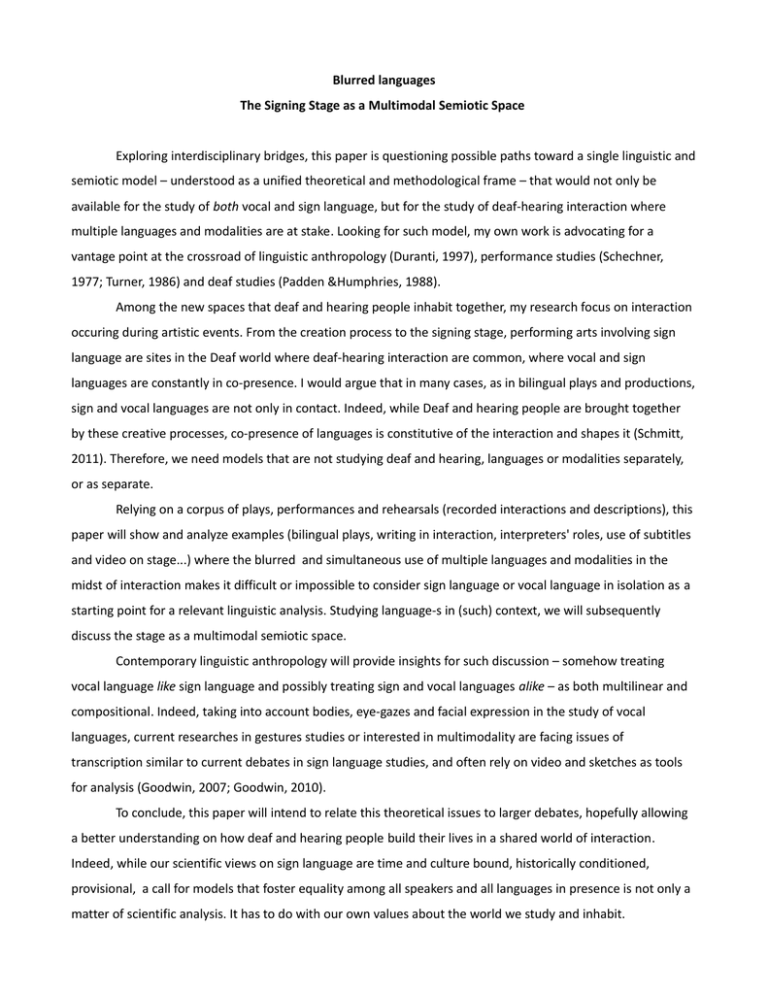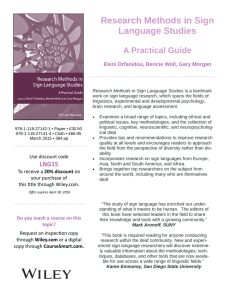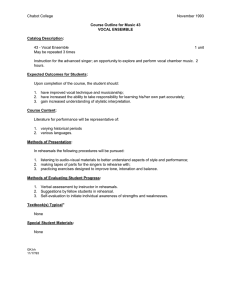Blurred languages The Signing Stage as a Multimodal Semiotic Space
advertisement

Blurred languages The Signing Stage as a Multimodal Semiotic Space Exploring interdisciplinary bridges, this paper is questioning possible paths toward a single linguistic and semiotic model – understood as a unified theoretical and methodological frame – that would not only be available for the study of both vocal and sign language, but for the study of deaf-hearing interaction where multiple languages and modalities are at stake. Looking for such model, my own work is advocating for a vantage point at the crossroad of linguistic anthropology (Duranti, 1997), performance studies (Schechner, 1977; Turner, 1986) and deaf studies (Padden &Humphries, 1988). Among the new spaces that deaf and hearing people inhabit together, my research focus on interaction occuring during artistic events. From the creation process to the signing stage, performing arts involving sign language are sites in the Deaf world where deaf-hearing interaction are common, where vocal and sign languages are constantly in co-presence. I would argue that in many cases, as in bilingual plays and productions, sign and vocal languages are not only in contact. Indeed, while Deaf and hearing people are brought together by these creative processes, co-presence of languages is constitutive of the interaction and shapes it (Schmitt, 2011). Therefore, we need models that are not studying deaf and hearing, languages or modalities separately, or as separate. Relying on a corpus of plays, performances and rehearsals (recorded interactions and descriptions), this paper will show and analyze examples (bilingual plays, writing in interaction, interpreters' roles, use of subtitles and video on stage...) where the blurred and simultaneous use of multiple languages and modalities in the midst of interaction makes it difficult or impossible to consider sign language or vocal language in isolation as a starting point for a relevant linguistic analysis. Studying language-s in (such) context, we will subsequently discuss the stage as a multimodal semiotic space. Contemporary linguistic anthropology will provide insights for such discussion – somehow treating vocal language like sign language and possibly treating sign and vocal languages alike – as both multilinear and compositional. Indeed, taking into account bodies, eye-gazes and facial expression in the study of vocal languages, current researches in gestures studies or interested in multimodality are facing issues of transcription similar to current debates in sign language studies, and often rely on video and sketches as tools for analysis (Goodwin, 2007; Goodwin, 2010). To conclude, this paper will intend to relate this theoretical issues to larger debates, hopefully allowing a better understanding on how deaf and hearing people build their lives in a shared world of interaction. Indeed, while our scientific views on sign language are time and culture bound, historically conditioned, provisional, a call for models that foster equality among all speakers and all languages in presence is not only a matter of scientific analysis. It has to do with our own values about the world we study and inhabit.




